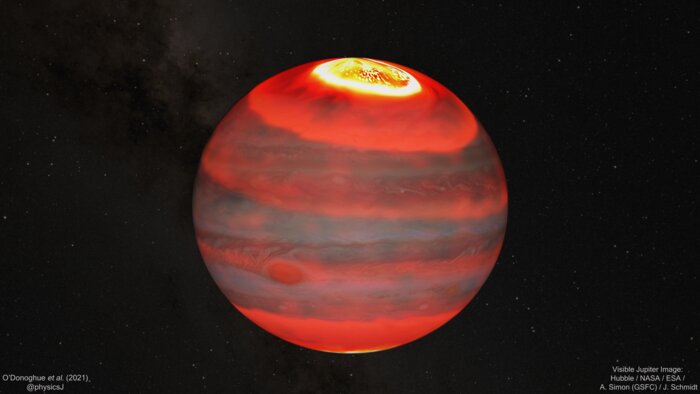
While understanding the universe is fantastic, it’s also great to understand our own solar system. There are still mysteries to be solved closer to home, and one of those is why Jupiter is so dang hot. Not just “oh the upper atmosphere is a little warmer than expected” kind of hot, either.
We know how much sunlight Jupiter receives based on its location, and the upper atmosphere should come in at about a brisk minus 70 degrees Celsius. Instead, that temperature is an immensely hot 425 degrees Celsius. This mystery has been frustrating planetary scientists for fifty years, and now we finally have the answer. James O’Donoghue, lead author of a new paper in Nature, explains: We found that Jupiter’s intense aurora, the most powerful in the solar system, is responsible for heating the entire planet’s upper atmosphere to surprisingly high temperatures.
You probably know what an aurora is based on the ones we have here on Earth. They occur when charged particles smack up against our magnetic field. The particles get caught up in the field and spiral along the field lines toward the poles, so we get the aurora Borealis and Australis – pretty lights that dazzle in the night sky. On Jupiter, these aurorae are supercharged with, as we learned recently, electrically charged particles coming from the material erupting on Io. Those particles are swept up by the solar winds and create enormous aurorae which are big enough and hot enough, it turns out, to heat the rest of Jupiter as well.
Per the press release: Global models of Jupiter’s upper atmosphere suggested that winds heated by the aurora and headed to the equator would be overwhelmed and redirected by westward winds driven by the planet’s rapid rotation. This would prevent the auroral energy from escaping the polar regions and heating the whole atmosphere. However, this new observational result suggests that such trapping is not occurring and that the westward winds may be relatively weaker than expected compared with equatorward winds.
Check out the links below to see more incredible graphics for this story.
More Information
Keck Observatory press release
“Global upper-atmospheric heating on Jupiter by the polar aurorae,” J. O’Donoghue et al., 2021 August 4, Nature




 Join the Crew!
Join the Crew!
 Escape Velocity Space News
Escape Velocity Space News
0 Comments